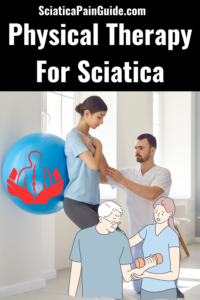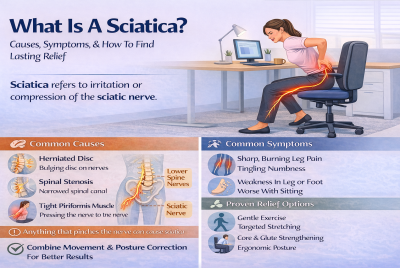Physical Therapy for Sciatica
Unlock relief with targeted exercises and holistic approaches in our guide on effective physical therapy for sciatica. Take charge of your well-being now! Sciatica, often described as a pain that radiates along the path of the sciatic nerve, can be a debilitating condition affecting millions worldwide. As someone passionate about sciatica awareness and relief, I believe in the transformative power of physical therapy in alleviating the discomfort associated with this condition. In this article, we’ll explore the various aspects of physical therapy for sciatica, providing valuable insights and practical advice for those seeking relief.
Understanding Sciatica
Sciatica is not just a pain in the leg; it’s a signal that something is amiss within the intricate network of nerves. Understanding the root causes, such as herniated discs, spinal stenosis, or muscle imbalances, is crucial. This insight helps tailor an effective treatment plan, making physical therapy a key player in sciatic relief.
Benefits of Physical Therapy
The benefits of physical therapy for sciatica are multifaceted. This non-invasive approach focuses on alleviating pain while improving mobility and functionality. Tailored treatment plans, guided by professional assessments, address the root causes of sciatica. Targeted exercises strengthen core muscles and enhance flexibility, offering long-term relief. Posture correction and ergonomic adjustments prevent further discomfort. Manual therapy techniques, such as massage and joint mobilization, provide immediate relief. Modalities like heat and cold therapy complement pain management. Home care and self-management empower individuals to participate actively in their recovery. Regular follow-ups and progress tracking ensure the adaptation of treatment plans for sustained well-being.
How We Treat Sciatica with Physical Therapy
Initial Assessment and Diagnosis
The journey to sciatic relief begins with a comprehensive assessment by a skilled physical therapist. This involves identifying the specific causes of sciatic pain and creating a customized treatment plan. A one-size-fits-all approach has no place in effective sciatica management.
Targeted Exercises for Sciatic Relief
Targeted exercises are pivotal in providing relief from sciatic pain. Strengthening core muscles plays a central role in stabilizing the spine and reducing pressure on the sciatic nerve. Incorporating specific stretches enhances flexibility and alleviates muscle tension. A personalized exercise routine, guided by a physical therapist, ensures tailored interventions for individual needs. These exercises address the symptoms and target the underlying causes of sciatica, promoting a comprehensive and effective approach to long-term relief. Consistency in performing these targeted exercises contributes significantly to improved mobility and reduced sciatic discomfort.
Posture Correction and Ergonomics
Neglecting posture can exacerbate sciatic pain. Proper posture and incorporating ergonomic practices into daily activities are fundamental to preventing further discomfort. Small adjustments in sitting, standing, and moving can significantly impact sciatic relief.
Manual Therapy Techniques
The hands-on approach of manual therapy, including massage therapy and joint mobilization, can provide immediate relief from muscle tension and nerve irritation. Skilled physical therapists employ these techniques to address specific areas contributing to sciatic pain.
Modalities for Pain Management
In addition to exercise and manual therapy, modalities like heat and cold therapy and electrical stimulation contribute to pain management. These complementary approaches enhance the overall effectiveness of physical therapy in alleviating sciatica.
Home Care and Self-Management
Home care and self-management form integral aspects of sciatica relief. Consistency in performing prescribed exercises at home, as guided by a physical therapist, is key to long-term success. Individuals are empowered to take an active role in their recovery, managing pain and preventing future episodes. Beyond exercises, adopting ergonomic practices, maintaining proper posture, and incorporating self-care techniques contribute to a holistic approach. By embracing self-management strategies, individuals can enhance their overall well-being and maintain progress between professional sessions, fostering a sense of control and ownership over their sciatic journey.
Progress Tracking and Adjustments
Regular follow-ups with a physical therapist ensure that the treatment plan aligns with the individual’s progress. Adjustments are made as needed, reflecting the dynamic nature of sciatica and the importance of adapting the approach accordingly.
Preventing Future Sciatic Episodes
Preventing future sciatic episodes involves adopting proactive measures. Maintaining a healthy weight, incorporating regular exercise, and practicing spine-friendly habits are paramount. Proper posture, ergonomic adjustments in daily activities, and avoiding prolonged sitting contribute significantly. Consistency in following a personalized exercise routine, as guided by a physical therapist, plays a crucial role in preventing the recurrence of sciatic pain. By embracing these lifestyle changes and staying mindful of spinal health, individuals can pave the way for a future free from the constraints of sciatica.
Alternative Therapies and Complementary Approaches
Exploring alternative therapies and complementary approaches enhances the efficacy of sciatica management. Practices such as yoga and tai chi promote flexibility and strength, complementing the benefits of physical therapy. Additionally, acupuncture and chiropractic care can offer targeted relief by addressing specific pain points. Integrating these complementary modalities into a holistic treatment plan provides individuals with a multifaceted approach to sciatic relief, catering to the diverse needs and preferences of those seeking alternatives to conventional medical interventions. It’s about creating a comprehensive strategy that synergistically alleviates sciatic discomfort.
Patient Testimonials and Success Stories
Real-life experiences speak volumes. Hearing from individuals who have found relief through physical therapy can inspire and motivate those on their sciatic journey. Success stories highlight the transformative impact of a well-crafted physical therapy plan.
Common Misconceptions about Sciatica Treatment
Common misconceptions about sciatica treatment often hinder individuals from seeking effective solutions. Dispelling myths, such as the belief that surgery is the only option or that rest alone can resolve the issue, is crucial. Understanding evidence-based practices is essential, as some may underestimate the transformative power of physical therapy. Educating individuals on the realities of sciatica, debunking unfounded notions, and emphasizing the effectiveness of tailored, non-invasive interventions contribute to informed decision-making. Clearing these misconceptions paves the way for individuals to explore diverse, evidence-backed avenues for managing and alleviating sciatic pain.
FAQs About Physical Therapy for Sciatica
How long does it take to see results with physical therapy for sciatica?
Results with physical therapy for sciatica vary, but many individuals experience relief within a few weeks of consistent therapy. The timeline depends on factors such as the severity of symptoms, adherence to the treatment plan, and the individual’s overall health. Regular communication with a physical therapist ensures adjustments are made as needed, optimizing the path to relief.
Is physical therapy the only treatment option for sciatica?
While highly effective, physical therapy isn’t the exclusive treatment for sciatica. Individual circumstances may warrant considering other interventions such as medications, injections, or, in severe cases, surgery. Consulting with a healthcare professional helps determine the most suitable approach, tailoring treatment to address the sciatic symptoms’ specific needs and severity.
Can I do physical therapy at home without professional guidance?
While some exercises can be done at home, attempting physical therapy without professional guidance may lead to improper techniques or exacerbate symptoms. A physical therapist ensures a personalized, safe approach, considering individual conditions. Consultation with a professional optimizes the effectiveness of home exercises for sciatica relief.
Are there any specific exercises to avoid during a sciatic episode?
Specific exercises like heavy lifting or intense impact activities may exacerbate sciatic pain during an episode. It’s crucial to avoid movements that strain the lower back and aggravate the sciatic nerve. Consulting with a physical therapist helps identify safe exercises and tailor a suitable regimen for individual circumstances.
Is physical therapy suitable for chronic sciatica?
Yes, physical therapy benefits chronic sciatica, providing sustained relief and improving overall quality of life. Tailored exercises, manual therapy, and ongoing guidance from a physical therapist contribute to managing chronic symptoms effectively. Consistency in following a personalized treatment plan is key to long-term success in alleviating chronic sciatic pain.
Physical Therapy for Sciatica – Conclusion
In conclusion, physical therapy emerges as a beacon of hope for those grappling with sciatic pain. From targeted exercises to hands-on techniques, it offers a holistic approach to managing and alleviating sciatica. As an enthusiast and advisor, I encourage anyone experiencing sciatic discomfort to explore the transformative potential of physical therapy for a life free from the shackles of pain. By committing to personalized treatment plans, individuals can regain mobility, improve functionality, and prevent future sciatic episodes. Embracing the comprehensive approach of physical therapy sets the stage for a journey towards lasting relief and enhanced overall well-being.
Disclaimer
Please note that the information provided in this article is for informational purposes only and should not replace professional medical advice. If you’re experiencing sciatica pain or any health concerns, it’s advisable to consult a healthcare professional for proper diagnosis and treatment.






